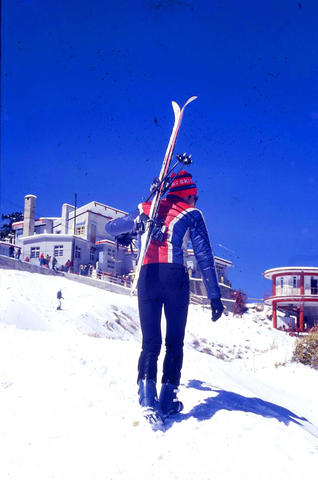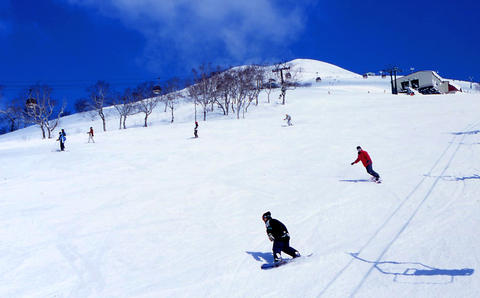On the slopes of Hohuanshan (合歡山), not far from the Central Cross-Island Highway (中部橫貫公路), stand the relics of Taiwan's attempt to build a center for skiing on the island. Not much remains now but a memory for men like Cheng Wen-feng (鄭文豐), the director of the Chinese Taipei Ski Association (中華民國滑雪滑草協會, CTSA), who 30 years ago was one of a small number of Taiwanese people who did not want living on a sub-tropical island to prevent them from enjoying skiing.
"That was still the time of martial law and most Taiwanese people were not allowed to travel abroad," he said in an interview in the association's cramped and cluttered offices.
With the advent of democracy, overseas travel became possible for Taiwanese sports enthusiasts who discovered that South Korea and Japan offered vastly more accessible ski facilities than Taiwan. As a result, in 1990 the ski operations on Hohuanshan came to an end.

PHOTO:COURTESY OF CHENG WEN-FENG, CHINESE TAIPEI SKI ASSOCIATION
Now, the association and some other tour operators offer specialized ski trips to these destinations, and the sport is gaining popularity. On the day we met, Cheng oversaw 10 pre-trip briefings alone with an estimated 2,000 people participating in ski trips organized by the association for this winter season.
Cheng recalled the early days of Taiwanese skiing when there were no lifts and skiers had to climb the hills that they skied down. "We weren't very good, but we were very fit," Cheng said with a laugh. "After all, Hohuanshan rises to over 3,000m, much higher than most international ski resorts."
As an active member of Taiwan's ski community, he oversaw skiing activities on Hohuanshan in the early 1980s and said that at its peak, they were seeing around 1,400 people skiing there every year. "The lift was built in 1973, but there were no funds to maintain it and it quickly became too dangerous to use," he said.

PHOTO: COURTESY OF THE JAPANESE TOURISM ASSOCIATION
The association was originally set up as an administrative base for training athletes for international competition, but these days Cheng's main task is to promote skiing in a nation where snow is generally only seen on the television. With a background in the tourism industry, he has high hopes of creating packages that cater to those who want a taste of something new.
"We have seen numbers increase very significantly in the last few years," he said. Under Cheng's leadership, the association has become more directly involved in organizing trips. "It is not always easy for conventional tour operators to understand the needs of ski tours," he said.
Steve Yang (楊士成), the general manager of Naruwan Tour (那魯灣旅行社), the only local travel agency with a significant offering of ski-specific travel packages, has also seen numbers grow gradually, but says the agency is able to carry this section of its business only because of his own personal commitment to the sport. His agency will have between 60 and 70 tour groups going out on dedicated ski packages this year. "But with only around 6,000 people, this is a drop in the ocean of Taiwan's travel industry," he said. "Taiwan has around eight million outward bound tourists a year, so it is a tiny percentage."
One of the greatest obstacles for Taiwanese people learning to ski, according to Cheng, is their total unfamiliarity with snow and even the very concept of skiing, a situation that poses unique learning challenges. "Many of our novice skiers have probably never even stood on snow before," Cheng said. "It can take them much longer than other people to find their balance ... so if they join a local (Japanese or Korean) ski school, they may quickly find themselves falling behind. This is not a good way to start."
For this reason, the CTSA has put great effort into training instructors to meet the needs of Taiwanese students. "These people are on the front line of providing the ski experience, so they are the most important people in helping promote skiing among the Taiwanese," Cheng said.
Yang, who used to manage travel plans for the CTSA but split from the association to establish his own ski tours through Naruwan Tour, has also established his own ski and snowboard school, and has gradually built up a cadre of instructors who accompany tours and help novice skiers.
"Many of them own their own companies, or are engineers in the Hsinchu Science Park (新竹科學園區), and so their time is limited," Yang said. His instructors gain their qualifications through the Canadian Ski Instructors Association's certification system. To improve the quality of tours, both Yang and Cheng emphasized the importance of the instructor-to-student ratio, especially as most packages cater to novice or intermediate skiers.
The CTSA has also drawn up its own certification guidelines based on Canadian and Japanese systems, and currently has over 60 certified instructors. "We hope to get the ratio down to one instructor for six to eight students," Cheng said. He says that this will address both safety and quality considerations.
Due to the lack of information about skiing and the difficultly in obtaining equipment locally, Yang's Naruwan operations have gradually grown from simply offering ski packages to importing and, in some cases, manufacturing entry-level ski equipment. A regular customer who owns a glove factory now provides gloves through Naruwan; the same goes for goggles, ski pants and other paraphernalia. "We don't want customers to feel they have to invest tens of thousands of dollars before they can go skiing," he said. "We do what we can to bring the price down for those wanting to ski for the first time." For those who have caught the ski bug, Yang also imports skies and boots to order. It is all a very long way from the regular business of running a travel agency.
Most Taiwanese skiers head to Japan, which has almost completely replaced South Korea as the destination of choice. "In the past, South Korea was significantly cheaper than Japan as a ski destination," Cheng said, "but in the last few years, due to the strengthening of the South Korean economy, prices are about the same, and the quality of both the snow and the facilities is significantly better in Japan." Both the CTSA and Naruwan stopped offering ski packages to South Korea this year.
Japan's reputation as a good destination for Taiwanese skiers has been pushed mainly by the local sports community rather than through active promotion of Japanese tourism authorities.
According to the Japan Tourism Association, efforts to promote skiing had virtually no impact and they no longer emphasize winter sports as part of their promotion campaigns. Cheng said that his own efforts to promote skiing through the media had stepped up a gear this year, and he hoped that this would be reflected in further growth next season.
Until now, the spread of skiing as a sport in Taiwan has been promoted largely through word of mouth, with Yang saying that almost half of their tours are packed with return customers. For companies such as Sunhi Tour (尚海旅行社), a small operation based in Ilan that specializes in customized travel packages, the return rate for ski trips is as high as 80 percent, according to owner Lei Chen-chou (雷震州).
Lei, a longtime tour leader, said that these groups are unique in Taiwan's tourist industry. "In most tour groups, when the trip is over, everyone goes their own way. The hardships endured as people learn to ski, and the help and support they give each other during the trip often develop into more enduring friendships," he said.
Lei attributes the fact that ski packages have been restricted to a tiny minority of agencies such as Naruwan and Sunhi to the dependence on a base of dedicated skiers who return every year.
Cheng hopes to change this and make skiing a mainstream holiday option for Taiwanese people. "Two of Taiwan's largest travel agencies have agreed to include our ski packages in their marketing channels," Cheng said, referring to Cola Tour (可樂旅遊) and Lion Travel (雄獅旅遊). "Big travel agencies such as Lion and Cola are able to offer facilities such as payment by installments, something that we cannot do," Cheng said. He expects this marketing push to begin by the end of February. He also said that plans are afoot to add English pages to the CTSA's Web site to allow foreign residents to participate in Taiwan's slowly developing ski tourism industry.

Most heroes are remembered for the battles they fought. Taiwan’s Black Bat Squadron is remembered for flying into Chinese airspace 838 times between 1953 and 1967, and for the 148 men whose sacrifice bought the intelligence that kept Taiwan secure. Two-thirds of the squadron died carrying out missions most people wouldn’t learn about for another 40 years. The squadron lost 15 aircraft and 148 crew members over those 14 years, making it the deadliest unit in Taiwan’s military history by casualty rate. They flew at night, often at low altitudes, straight into some of the most heavily defended airspace in Asia.

Beijing’s ironic, abusive tantrums aimed at Japan since Japanese Prime Minister Sanae Takaichi publicly stated that a Taiwan contingency would be an existential crisis for Japan, have revealed for all the world to see that the People’s Republic of China (PRC) lusts after Okinawa. We all owe Takaichi a debt of thanks for getting the PRC to make that public. The PRC and its netizens, taking their cue from the Chinese Communist Party (CCP), are presenting Okinawa by mirroring the claims about Taiwan. Official PRC propaganda organs began to wax lyrical about Okinawa’s “unsettled status” beginning last month. A Global

Taiwan’s democracy is at risk. Be very alarmed. This is not a drill. The current constitutional crisis progressed slowly, then suddenly. Political tensions, partisan hostility and emotions are all running high right when cool heads and calm negotiation are most needed. Oxford defines brinkmanship as: “The art or practice of pursuing a dangerous policy to the limits of safety before stopping, especially in politics.” It says the term comes from a quote from a 1956 Cold War interview with then-American Secretary of State John Foster Dulles, when he said: ‘The ability to get to the verge without getting into the war is

Like much in the world today, theater has experienced major disruptions over the six years since COVID-19. The pandemic, the war in Ukraine and social media have created a new normal of geopolitical and information uncertainty, and the performing arts are not immune to these effects. “Ten years ago people wanted to come to the theater to engage with important issues, but now the Internet allows them to engage with those issues powerfully and immediately,” said Faith Tan, programming director of the Esplanade in Singapore, speaking last week in Japan. “One reaction to unpredictability has been a renewed emphasis on